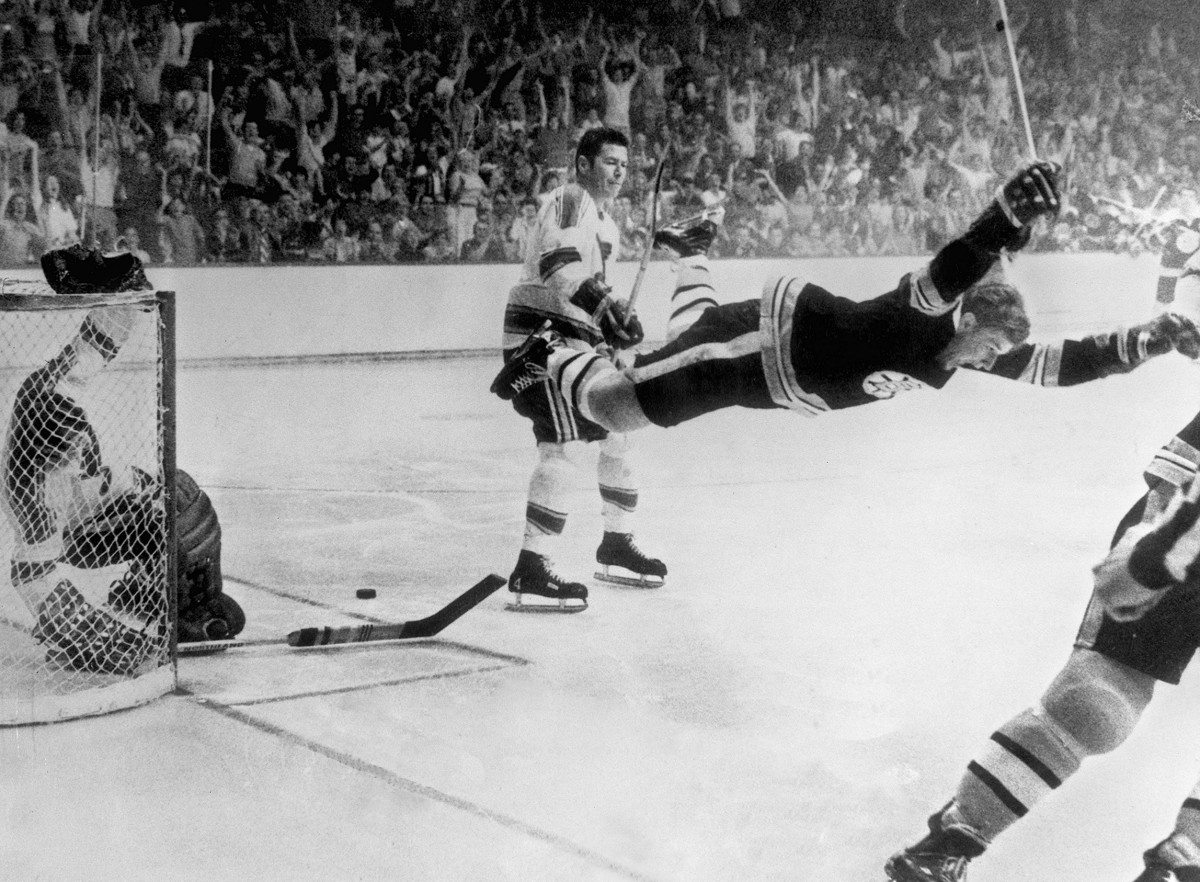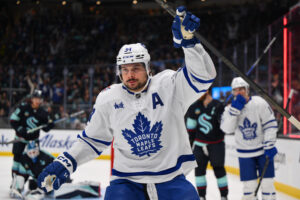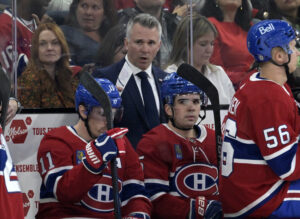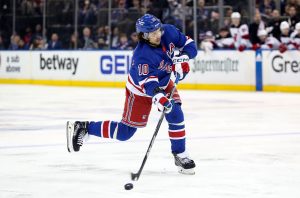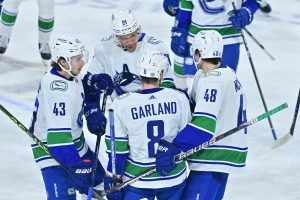Bobby Orr of the Boston Bruins, as you will be taken a journey through to see, is the GOAT of hockey. When it comes to GOAT status in NHL circles, the list is short, as it should be, to honour its integrity. Being short is much the same as how it is in other sports. Therefore, the following is a humble and honest attempt to not stir any controversy. The GOAT hockey list is as follows in no particular order other than loosely chronologically:
The runner-up list is a bit more debatable but includes the likes of Guy Lafleur, Gordie Howe, Mike Bossy, Sidney Crosby, Alex Ovechkin, and Eddie Shore. Moreover, goalies did not quite seem suitable for the list. It has been so competitive for a number of years and seems more era-dependent. The names on the goalie list would include the likes of: Dominik Hasek, Patrick Roy, Martin Brodeur, Ken Dryden, Johnny Bower, or Jacques Plante.
Bobby Orr Is the NHL’s GOAT
What Quantifies GOAT Status in Hockey
A GOAT, an athlete who can be recognized as the greatest of all time in their respective sport, must indeed be bigger than the sport. Perhaps one specific statistic to support the argument, and also very simplistic, is points per game (PPG), just from a deviation standpoint. Another metric would be to count the number of Stanley Cup rings. We could also consider international accolades, but this is not necessary for our purposes. Only McDavid of the top candidate list has yet to achieve success in the playoffs. Some may argue what success McDavid and his Oilers have achieved is noteworthy given the rosters they’ve had on a couple of playoff runs.
Notes on Other GOATs
A couple of notes on another member of the top candidate list, Maurice ‘The Rocket’ Richard, are worth mentioning. Richard is the epitome of a superstar athlete who carried his sport. He revitalized Francophone culture and gave everybody in Quebec, La Belle Province, a superhero and a role model.
This was best evidenced by the “Richard Riot” when in the 1954-55 season Richard was suspended on March 13th for the remainder of the regular season and playoffs. With the NHL president at the time, Clarence Campbell, attending the Canadiens’ next home game it was enough to fuel Richard’s supporters to riot. The only way the rioters could be contained was from Richard himself making pleas with them to restore order. The suspension ultimately cost Richard a shot at a scoring title, a feat he never did achieve. There is some consensus, among the French hockey community, that Richard was sometimes gypped second assist points, to favour his peers’ odds at scoring titles. To add to what makes him a GOAT candidate, Richard did have eight Stanley Cups. Conversely, another great, Gordie Howe, nullified much of his statistical prowess. Howe captured six scoring titles, five of which are during their career overlaps.
The Runner-Up: Number 99
The other GOAT runner-up to Bobby Orr that without mention would be a fault is the ‘Great One’, Wayne Gretzky. At the outset of the 2021-22 NHL regular season Gretzky still held at least a share of many of the 60 significant NHL records that he had when he retired. What makes many of his records so outstanding is his gap between second place. For most goals in a single regular season, Gretzky scored 92, while only Brett Hull and Mario Lemieux have eclipsed 85. Additionally, when it comes to career point totals, Gretzky has a 936-point lead over second place Jaromir Jagr. Gretzky’s assist total of 1963, is still more than Jagr’s point total, and Gretzky is the all-time leader in goals scored. He tallied 200 points four times, and only one other player came close once, with Lemieux’s 199 in 1988-89.
Gretzky is very likely the top-runner up to our Bobby Orr GOAT selection. However, he did not play the complete game. There are many conflicting thoughts on his defensive acumen. Yes, he was fast, covered the entire surface, and was proficient at stealing the puck from opponents. In contrast, he was not a strong checker. Also, despite his scoring dominance, it translated to only four cups. A long-time teammate, Mark Messier, was able to amass six cups throughout his career. Thus, our selection for GOAT was the complete package. Robert Gordon Orr, more affectionately known as number four Bobby Orr. He did it all, which we will go into but first, let’s take a look at how it got started.
How the Maple Leafs Missed Out on Bobby Orr
The window was small, but the Toronto Maple Leafs did have the first opportunity at Bobby Orr, albeit as a 12-year-old. Orr’s peewee team had the opportunity to visit Maple Leaf Gardens. In appreciation, Orr’s coach at the time, Anthony Gilchrist, wrote a letter to thank the Leafs general manager Punch Imlach. Along with giving thanks, he suggested that the Leafs send some personnel to a couple of upcoming games to watch Orr play. He went on to add a comment that they might want to do this before the Barrie Flyers owner, Hap Emms, scoops him up.
Punch Imlach did as expected, and passed the letter onto his chief scout Bob Davidson. Davidson’s response was that Orr was too young. He said that the only way a junior club could protect him was that Orr moved to that city, something very unlikely for a 12-year-old.
Bobby Orr would never become a Maple Leaf, however, the Toronto connection did carry on somewhat. Orr’s first season for Oshawa, as a 14-year-old in 1962-63, saw them play home games at the Maple Leaf Gardens. Oshawa was awaiting the completion of their new arena. Also, there was an exhibition game in which the Toronto Marlies availed Orr’s services in December of 1965 against the USSR’s top team.
The Boston Bruins Connection
Hap Emms founded the Barrie Flyers organization, a team that existed from 1945 to 1960. They were very successful, which included two national titles, the 1951 and 1953 Memorial Cups. As coach of the Barrie Flyers, Hap Emms had players such as Don Cherry and Ed Westfall (Orr’s teammate during the cup years in Boston). Conveniently, Barrie was a team sponsored by the Boston Bruins. So, Boston did have a strong presence in the area, which Davidson was responding to in the letter. Now, the Flyers did end up moving to Niagara Falls in the 1960 season, but Boston still maintained its sponsorship affiliation to the organization. During 1965-66 and 1966-67 (Orr’s NHL rookie season), Emms was the general manager of both the Niagara Falls Flyers and the Boston Bruins. He is credited with promoting Harry Sinden to coach in 1966.
Committing to the Oshawa Generals
Now, so far we have not mentioned how the eventual GOAT ended up with his junior club. Cue hockey pioneer, Wren Blair. In 1953, after a fire tragically burned down the Hambly Arena, the Oshawa Generals of the OHA were forced to disband. Blair was able to salvage some of the pieces and created a Senior B club. They would play out of Bowmanville, the Oshawa Truckmen. The following year, this team became the Whitby Dunlops. What’s more, with Blair as the general manager of the club, they would go on to become the 1956 Olympic Team Canada representative. As a sidebar, a member of this club was ironically enough, Harry Sinden.
Around 1960, with Blair well established in the local and world hockey scenes, he began negotiations with Boston Bruins president Weston Adams. The deal went something like this: if the Boston Bruins wanted a sponsorship deal, with the re-birth of the Oshawa Generals, they would have to help build the Oshawa Civic Auditorium. It was also around this time that Blair had discovered for himself at a playoff game in Gananoque, ON, the star in the making. In this case, it seems the stars were aligning.
The First Big Step
Blair was able to convince Orr’s family to go to a tryout with the Niagara Falls Flyers as a 13-year-old. At this point, Weston Adams stepped in, saying Orr was too young for such a venture, sending the boy back home to Parry Sound. It seems a bit of a chicken before the egg scenario, as this is probably where Adams decided to go forward with the Oshawa deal. Apparently, it ended up being Blair who was able to work through the details with the Orr family. He was able to sign Orr under some ‘unique’ circumstances. Most notably, Orr would be playing for the newly formed Oshawa Generals, not the Flyers.
Some of these unique circumstances of the deal are worth mentioning. The main idea was that Orr would be able to remain with his family in Parry Sound, given its proximity to Oshawa. A further stipulation was as a signing bonus, a car, for his father, but it was said that it couldn’t have been anything newer than a ’58. The rest as they say is history.
Orr supplanted himself as a star during his time in Oshawa. In his final two seasons with Oshawa, he tallied 93 and 94 points, respectively. Moreover, in his final season, 1965-66, he led the Generals to their first Memorial Cup final in 22 years. They would lose in the final in six games, to the Edmonton Oil Kings, a series where Orr played mostly hurt.
The Dough and the Show for Bobby Orr and the Boston Bruins
As we can see, by the time Orr got to the NHL, he was destined to be the greatest. He signed his six-figure contract in 1966, making him the highest-paid hockey player ever at the time. He debuted that year under head coach Harry Sinden. As the season began, Orr did not disappoint. He would go on to win the Calder as the league’s top rookie that season. In contrast, the team struggled, finishing in last place in the six-team league, and had failed to make the playoffs again, dating back to 1958-59.
Their recently appointed general manager Milt Schmidt was determined to change their fortunes. Schmidt traded for Phil Esposito, in what is thought to be a historically lopsided transaction. Boston also received Fred Stanfield and Ken Hodge, players who would become stalwarts throughout the next number of years. Between Orr and the trade, this truly was the beginning of the Boston Bruins franchise turnaround.
Becoming the Big, Bad Bruins
A huge contribution to the breadth of Orr’s GOAT status was the moniker of the Big, Bad Bruins of which he was an integral part. Teammate Ken Hodge once summed up the team with the slogan “One throw, All for One.” If someone were to throw a hit on Orr, that meant they were hitting the whole team, and they would pay. As a result of the turnaround, and Boston’s newly minted identity, the Bruins made a push for the post-season in 1967-68.
Orr was off to a record-setting pace in the 1967 season. He had accumulated 31 points in 46 games, and then he got hurt. There was so much hype on making their long-awaited return to the playoffs, that the injury stunned them. Orr would return for the playoffs, but they were unable to make a run. Despite only suiting up for 46 games, Orr still earned a first-team all-star selection. Even more impressively, Orr captured his first Norris Trophy as the league’s top defenseman.
For the 1968-69 season, the league was keenly aware there was something special in Orr and with the entire Bruins organization. One of his peers, Jean Beliveau once said of him, “Nobody is a perfect hockey player. The important thing is to correct your mistakes. Orr, he does that.” Within the team, this season saw an NHLer eclipse the 100-point plateau for the first time ever. Phil Esposito did it. Moreover, for Orr, he was able to set the record for points in a season by a defenseman at 64. The previous mark for a defenseman in a season was 59. He also flexed his toughness, adding on a career-high 133 penalty minutes. Even though he was often injured, his toughness was never questioned. It was rumoured he played his entire career without shoulder pads.
Orr’s Recognition as Great
In addition to his toughness, he was often praised and recognized for his abilities and individual performance. Sports Illustrated writer E.M. Swift encapsulated his abilities, stating “Orr was more than an opportunist: He created opportunities.” He was an eight-time Norris winner, three-time Hart winner, and once captured the Lester Pearson. Orr was the first out of Gordie Howe and Maurice Richard to win three consecutive MVP titles. In addition, one more trophy Orr claimed, the Art Ross, which he is the only rearguard to win, and he did it twice. One of Esposito or himself would win the award for seven consecutive seasons. Needless to say, his trophy case was extensive.
52 years ago today, Bobby Orr scored the #StanleyCup winning goal against the St. Louis Blues and one of the most iconic hockey photos was born. 🏆
📸: Ray Lussier pic.twitter.com/Jctsak9q3X
— Sportsnet (@Sportsnet) May 10, 2022
Of course, what GOAT’s trophy case wouldn’t be complete without some post-season silverware? In 1970, Orr would help the Bruins claim their first crown in 29 years. This was the scene of his infamous goal, flying through the air, space, and time. Amazingly, this season would see him become the first player ever to win four individual awards. Included in the four are the Norris, Hart, Art Ross, and adding his first of two Conn Smythe awards.
Even though it did not end with a Stanley Cup, the 1970-71 season saw Orr hit his career high in points, with 139. He didn’t even win the Art Ross, thanks to teammate Phil Esposito’s memorable 76-goal, 76-assist campaign. The two teamed up for 45 goals that season. They either assist on one another’s goals or both assist on another player’s goals. Over the next few years, Orr would go on to put up many scoring records, which still rank top amongst defensemen of all time.
A Look at the Evidence of Bobby Orr’s Brilliance
Let us elaborate on some of his statistical significance. He is one of only five defensemen with a 100-point season. One reason why last year Roman Josi had a 96-point total was such an outlier. Back to Orr, who would end up collecting six, 100-point seasons in a row. His ability to quarterback the play, and make pinpoint passes was attributed to an early coach. He is the one who is credited with moving Orr from forward to defence. In Orr’s autobiography, Orr: My Story, he told Orr to: “never get rid of the puck when you can control it. Hold on to it and let the play open up in front of you.” Orr remains the only defenseman to lead the league in assists, and he did it five times. The 100-assist in a year club is exclusive: Wayne Gretzky (11 times), Mario Lemieux, and Orr.
Along with the points and passing, Orr’s goal stats are also remarkable. Such is the case Orr scored 20 plus goals for seven straight seasons. When he entered the league, no defenseman had accomplished that feat even once in 20 years. Furthermore, five times he scored 30 plus goals. In the top-10 list of most goals in a season by a defenseman, Orr appears five times. Orr’s last triumphant campaign, 74-75, was a magical one. Don Cherry summed it up in his book, Hockey Stories Part 2: “I’ve said many times, he had 46 goals, 89 assists, plus-128, fought a lot that year, hit a lot that year and blocked a lot of shots.” This total of 46 is second all-time only to Paul Coffey’s 48 in 1985-86. Orr would have one final curtain call, claiming the outstanding player award at the 1976 Canada Cup.
The Gentleman, The Legend
It seems otherworldly, that one man could redefine a position, and do it so eloquently. He was a true gentleman, one who played with speed, finesse, and power. As a 13-year-old kid, he tried out against 20-year-olds and played at 14. He could achieve great success by being tough and playing a complete game. He elevated the players around him, such as the great Phil Esposito. One final stat to throw out there for the modern analytic side of the coin, Orr had a 45.6 goal above replacement value average over his best five seasons, peaking at 49 in his 70-71 season. (As a comparison, Josi was around 20 this past year). He would lead the rush offensively and be the first one back to block shots. Orr was the greatest, and those of us, who watched him play, should be forever thankful.


